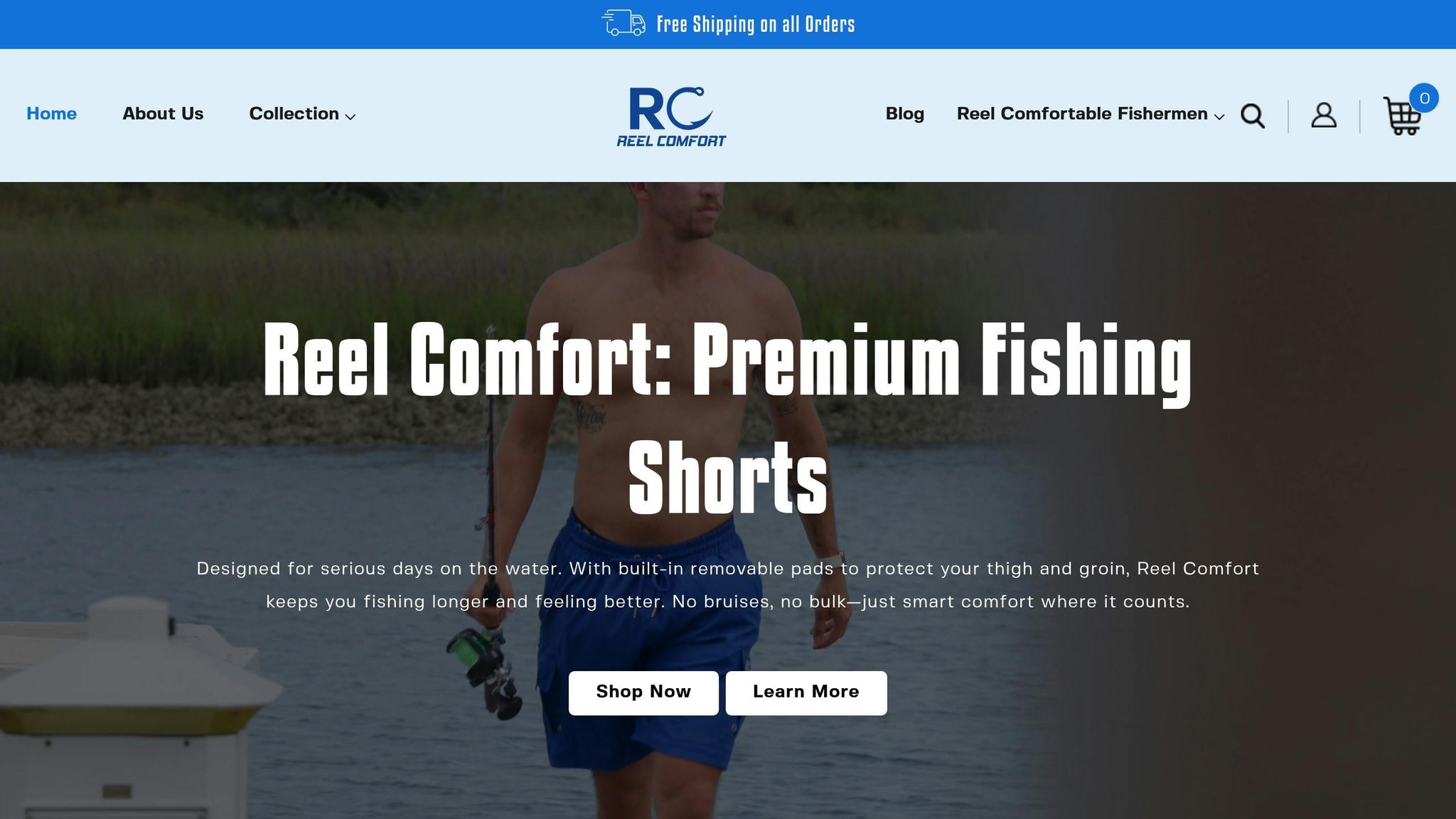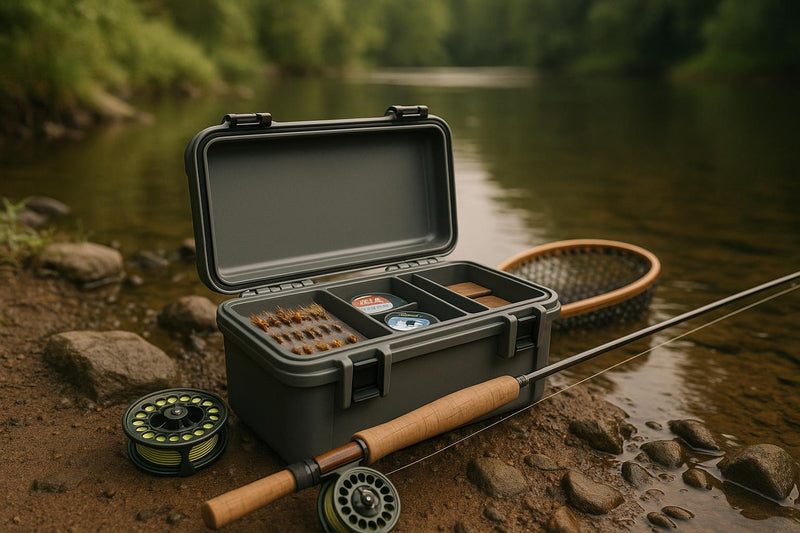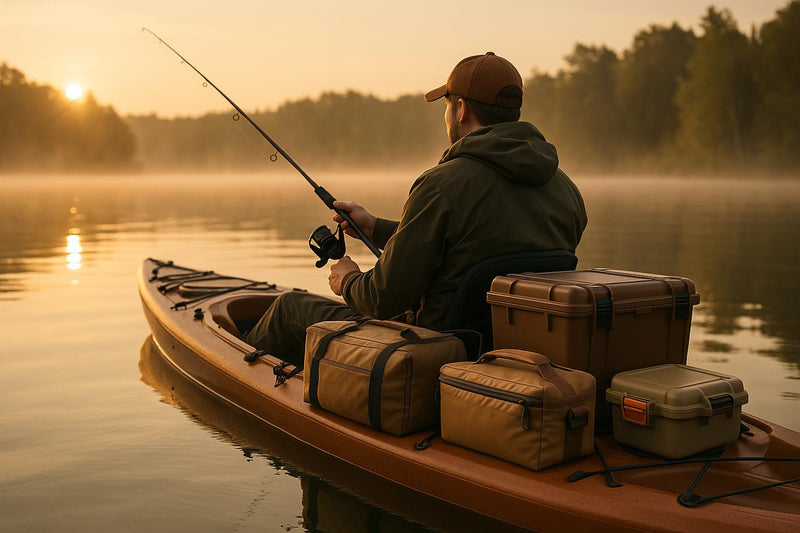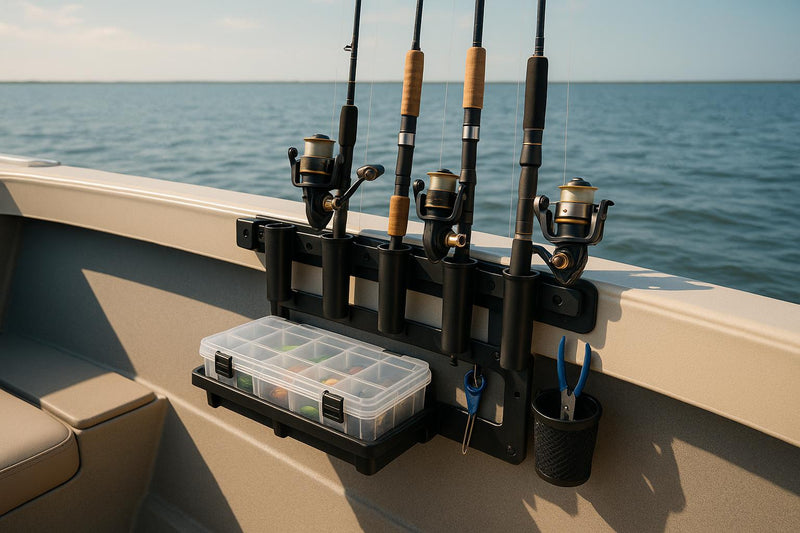Moisture-wicking fabrics are a game-changer for anglers facing long hours under the sun, heat, and humidity. These fabrics reduce chafing by drawing sweat away from the skin, allowing it to evaporate quickly. This keeps you dry, minimizes friction, and prevents irritation, even in challenging fishing environments. Key causes of chafing include sweat, saltwater, and poorly chosen clothing. The right gear - like fishing shorts made from synthetic, quick-dry materials - can keep you comfortable, protect your skin, and help you focus on your catch.
Tips to Avoid Chafing:
- Choose moisture-wicking, quick-dry fabrics like polyester or nylon.
- Look for features like anti-chafe seams, breathable panels, and UV protection.
- Avoid cotton, as it traps moisture and increases friction.
- Keep your gear clean and follow proper care instructions to maintain performance.
Investing in well-designed fishing shorts with moisture-wicking properties can make your trips more enjoyable and irritation-free.
What is Chafing and Why Does it Happen
What is Chafing?
Chafing is a painful skin irritation that happens when your skin repeatedly rubs against either other skin or fabric. For anglers, what starts as a minor annoyance on a long fishing trip can quickly turn into a major source of discomfort.
"Chafing is a common skin problem caused by any combination of friction, moisture, and irritating fabric. Prolonged rubbing on the skin makes your skin sting or burn, and you develop a mild, red rash. In severe cases, chafing may progress to swelling, bleeding, or crusting."
Initially, it may appear as mild irritation, but if ignored, it can escalate to red bumps or even blisters. Long fishing trips, where movement is constant and conditions are humid, often speed up this process.
Thigh chafing is the most frequent culprit for outdoor enthusiasts, including anglers. Every step, cast, or maneuver around the boat causes the thighs to rub together, and repetitive movements amplify the friction.
Now, let’s break down why fishing environments make chafing so common.
Main Causes of Chafing
Fishing introduces a mix of conditions that increase the likelihood of chafing. Understanding these triggers can help you take steps to prevent it from ruining your day on the water.
At the heart of the issue is friction from constant movement. Whether you’re casting, walking along the shore, or adjusting your position on the boat, skin-on-skin or fabric-on-skin contact is unavoidable. Moona Page, senior apparel design manager for Columbia Sportswear, describes the process well:
"It's the combination of sweat and friction - skin rubbing together. That can cause anything from irritation to red bumps to blisters. It is very uncomfortable when you're walking or hiking."
When your skin gets wet from sweat or water, it softens, making it more vulnerable to damage. Heat and humidity only worsen the situation by increasing sweating, which raises the risk of irritation. To put it into perspective, around 15.3 million Americans deal with excessive sweating.
Saltwater fishing brings its own unique challenges. As seawater dries on your skin, it leaves behind salt crystals that act like tiny abrasives, speeding up chafing. Dr. Jim Miller from the FINA Sports Medicine Committee explains:
"Salt water is much more irritating than fresh water and as the athlete begins to chafe it burns and results in them changing their stroke mechanics."
The clothing you wear also plays a major role. Ill-fitting garments - whether too tight or too loose - create pressure points that irritate the skin. Fabrics that trap moisture instead of allowing it to evaporate make the problem worse. That’s why wearing the right fishing shorts is key for staying comfortable during long outings.
For anglers, long hours in the sun and repetitive movements compound the problem. Direct sunlight, combined with reflections off the water, raises your body temperature and increases sweating. Meanwhile, wind and water spray create cycles of wetting and drying, leaving behind salt that makes fabric stick to your skin. Dehydration, a common issue during fishing, also dries out your skin, making it more prone to irritation.
These combined factors explain why anglers often deal with chafing in multiple areas at once - thighs, groin, underarms, and anywhere clothing rubs. By understanding these causes, you can make smarter gear choices to keep chafing at bay.
How Moisture-Wicking Fabrics Stop Chafing
How Moisture-Wicking Works
Moisture-wicking fabrics are designed to draw sweat away from your skin and allow it to evaporate quickly. This process relies on capillary action, where the fabric pulls moisture to its surface for faster drying. Unlike cotton, which tends to hold onto moisture, these fabrics are built for performance. Many high-quality options feature a dual-layer system: a hydrophobic inner layer that repels water and a hydrophilic outer layer that spreads moisture out for rapid evaporation.
By minimizing moisture retention, these fabrics improve airflow and enhance cooling. For anglers, this means staying comfortable even during long hours on the water. The ability of these fabrics to disperse moisture over a wide area keeps them from sticking to your skin, reducing friction and helping to prevent irritation. This efficient moisture management isn't just a feature - it's a game-changer for anyone spending extended time outdoors.
Benefits for Anglers
Moisture-wicking fabrics bring a range of advantages to anglers, especially on long fishing trips. First and foremost, they help keep your skin dry, which in turn reduces friction and prevents chafing. This is particularly important in hot, humid conditions, where sweat buildup can lead to uncomfortable "hotspots." By pulling moisture away from the skin and spreading it across the fabric for quick evaporation, these materials help you stay comfortable and irritation-free.
Another major benefit is temperature regulation. Moisture-wicking fabrics help maintain a steady body temperature, preventing overheating even when you're casting under the blazing sun or navigating a boat deck. Features like flatlock seams, breathable mesh panels, and laser-cut ventilation further reduce friction and enhance comfort during movement.
Investing in quality Mens Fishing Shorts with moisture-wicking properties can make a world of difference. Not only do they keep you comfortable, but they also limit the growth of odor-causing bacteria by keeping your skin drier throughout the day. For the best results, look for clothing labeled with terms like "performance fabric", "sweat-wicking", or "quick-dry". These features ensure that you can focus on the thrill of the catch without being distracted by discomfort.
Want to make smarter gear choices? Dive into quick-dry fabric technology to learn more, or explore water-resistant gear for additional ways to stay protected in tough fishing conditions.
How to Choose the Best Fishing Shorts for Long Trips
Features to Look For
When selecting fishing shorts for extended trips, focusing on comfort and functionality is key. To avoid discomfort and chafing, choose shorts designed with features that enhance your experience on the water.
Start by opting for shorts made from synthetic materials like polyester or nylon. These fabrics excel at wicking moisture away from your skin and drying quickly, unlike cotton, which tends to hold onto moisture and increase the risk of irritation. Look for anti-chafe seams to minimize friction in high-contact areas, ensuring greater comfort during long hours of casting, walking, or sitting.
Quick-dry fabrics are a must-have, as they allow moisture to evaporate swiftly through advanced capillary action. But moisture management is just the beginning. Here are additional features to seek out:
- Breathable panels or mesh inserts to promote airflow
- Water-resistant finishes to shield against splashes and spray
- Reinforced zones in areas prone to wear and tear
- Ample storage pockets for tackle and personal items
- Four-way stretch materials to enable unrestricted movement
- Built-in UV protection to guard against harmful sun exposure
Fit is another critical factor. Shorts that are too tight can create friction, while overly loose ones may bunch up and cause rubbing. Adjustable waistbands and stretchy panels can help you achieve the perfect fit for all-day comfort, keeping you focused on reeling in your next big catch.
Reel Comfort's Premium Fishing Shorts

If you're after a pair of fishing shorts that combine cutting-edge design with long-lasting comfort, Reel Comfort's Fishing Shorts are an excellent choice, priced at $59.99. These shorts are tailored for anglers who want the best in performance and practicality.
Crafted from quick-dry, water-resistant fabric with moisture-wicking properties, these shorts actively draw sweat away from your skin and help it evaporate fast, reducing the chances of chafing during long outings.
One standout feature is the removable thigh pads, designed to provide critical rod support when needed. These pads offer cushioning without restricting movement and can be easily taken out when not in use. The ergonomic design ensures full mobility, whether you're casting from the shore or navigating a boat deck.
Storage is another strong suit. With deep hand pockets, a secure zippered back pocket, and slim thigh-pad pockets, you'll have plenty of room to organize your gear. The shorts are built to last, thanks to reinforced stitching and durable rip-stop fabric that can handle the demands of frequent fishing trips.
Available in classic black, versatile gray, and bold blue, these shorts strike the perfect balance between performance and style. Four-way stretch panels and anti-chafe seams ensure irritation-free wear, even during marathon fishing sessions.
Ready to elevate your fishing experience? Check out Reel Comfort's Fishing Shorts and enjoy unmatched comfort on every trip.
For more insights into fabric technology and fishing gear, explore their guides on quick-dry fabric technology or the differences between padded fishing shorts and regular shorts to make an informed decision for your next adventure.
sbb-itb-cb0a783
Moisture Wicking Fabrics - An Explanation
How to Care for Moisture-Wicking Fishing Apparel
Taking care of your moisture-wicking fishing gear is key to keeping it functional and long-lasting. These fabrics are designed with synthetic fibers that excel at keeping you dry and comfortable, but they need specific care to maintain those properties.
Best Practices for Washing
Always check the care label on your garment before washing - it’s there to guide you in maintaining the fabric’s performance.
"The care label in the garment is there to help the consumer maintain the performance of the product they purchased, so taking a note of it is good"
Here are some essential tips for washing your fishing apparel:
- Stick to cold water. Washing in hot water can damage the synthetic fibers, reducing their ability to wick moisture effectively. Always turn your gear inside out and wash with similar colors in cold water.
- Skip the fabric softener. While it might seem helpful, fabric softeners can coat the fibers, clogging the tiny pores that help move moisture. This coating also traps sweat and bacteria, leading to unpleasant odors and reduced breathability. The same rule applies to dryer sheets - avoid them.
- Choose the right detergent. Opt for powdered detergents or specialized sports detergents like HEX Performance Laundry Detergent (priced at $0.41 per load). These are formulated to lift sweat and oils from synthetic materials without leaving residue. Regular detergents can leave behind chemicals that block the fabric’s pores.
- For extra cleaning power: If your gear smells particularly bad after a long fishing trip, pre-soak it in a mix of one part vinegar to four parts water before washing. Another quick tip? Rinse your gear with cold water immediately after use to wash away bacteria and prevent odors from setting in.
- Wash inside out. This protects the outer layer of your gear while ensuring the inner surfaces - where sweat and bacteria accumulate - are thoroughly cleaned.
Once washed, drying your gear the right way is just as important.
Drying Tips
To preserve the moisture-wicking properties and overall durability of your fishing apparel, air-drying is your best bet. High heat from dryers can weaken synthetic fibers, affecting their shape and performance.
- Air-dry in a ventilated area. Avoid direct sunlight, as it can fade colors and weaken fibers over time. If you must use a dryer, choose the lowest heat setting.
- Handle specialized features with care. For example, if your gear includes removable padding - like the thigh pads in Reel Comfort's fishing shorts - air-drying ensures these elements stay intact and functional.
- Skip the iron. Most moisture-wicking fabrics are wrinkle-resistant, so ironing is rarely needed. If you must iron, use the coolest setting and avoid areas with logos, designs, or padding.
Conclusion: Stay Comfortable and Chafe-Free
When it comes to long fishing trips, moisture-wicking fabrics have become a game-changer for anglers, tackling one of the most common annoyances: chafing. These advanced materials work by pulling moisture away from your skin through absorption and evaporation, leaving you dry and reducing friction that causes irritation.
Here’s the deal: unlike cotton, which tends to hold onto sweat, moisture-wicking fabrics ensure sweat is quickly moved away from your skin. This keeps you dry and prevents the sticky, uncomfortable conditions that lead to chafing during hours of casting and reeling. For anglers, this means less time worrying about discomfort and more time focusing on the fish.
Whether you’re on the boat or along the shoreline, these fabrics offer real comfort and performance. The quick-dry properties are especially helpful in wet or humid conditions, ensuring that your focus stays on landing the big catch - not on irritation or discomfort.
To make the most of this technology, consider investing in fishing shorts designed with moisture-wicking properties and practical features. For example, Reel Comfort’s Fishing Shorts combine quick-dry, water-resistant fabric with removable thigh pads, ergonomic design, and ample storage pockets. At $59.99, they’re built to handle the challenges of long fishing trips while keeping you comfortable.
Take care of your gear to maintain its performance over time. Quality Men's Fishing Shorts with moisture-wicking technology aren’t just about staying comfortable - they’re about fishing longer, performing better, and enjoying every moment on the water without distraction. Explore the collection and gear up for your next adventure.
FAQs
What makes moisture-wicking fabrics better than cotton for preventing chafing?
Moisture-wicking fabrics are crafted to keep your skin dry by drawing sweat away from your body and letting it evaporate quickly. This feature helps minimize the friction that often leads to chafing, especially during long activities like fishing trips.
On the other hand, cotton tends to absorb moisture and hold onto it, which can leave you feeling damp, irritated, and uncomfortable. Materials like polyester or nylon, known for their moisture-wicking properties, are lightweight, breathable, and quick to dry. These qualities make them a smarter option for staying comfortable and avoiding chafing during extended outdoor adventures.
What features should I consider in fishing shorts to help prevent chafing on long trips?
When picking fishing shorts to avoid chafing, focus on moisture-wicking and quick-drying fabrics. These materials help keep sweat and water off your skin, reducing irritation. Choose lightweight and breathable fabrics to promote airflow and prevent overheating. Additionally, shorts with flatlock seams or a seamless design are ideal, as they minimize friction. An ergonomic fit is also key, allowing for natural, unrestricted movement.
These features not only enhance comfort but also ensure durability, making them perfect for long days on the water while keeping you chafe-free and focused.
How do I care for moisture-wicking fishing apparel to keep it performing at its best?
To maintain the performance of your moisture-wicking fishing gear, always wash it in cold water with a mild detergent. Steer clear of fabric softeners - they can interfere with the fabric's moisture-wicking properties. Once cleaned, either air dry your apparel or use a tumble dryer set to low heat to preserve the integrity of the fibers.
For extra upkeep, give your clothes a quick rinse in cold water after each use. This helps remove sweat, bacteria, and odors, keeping your gear fresh and ready for your next fishing adventure while prolonging its lifespan.




